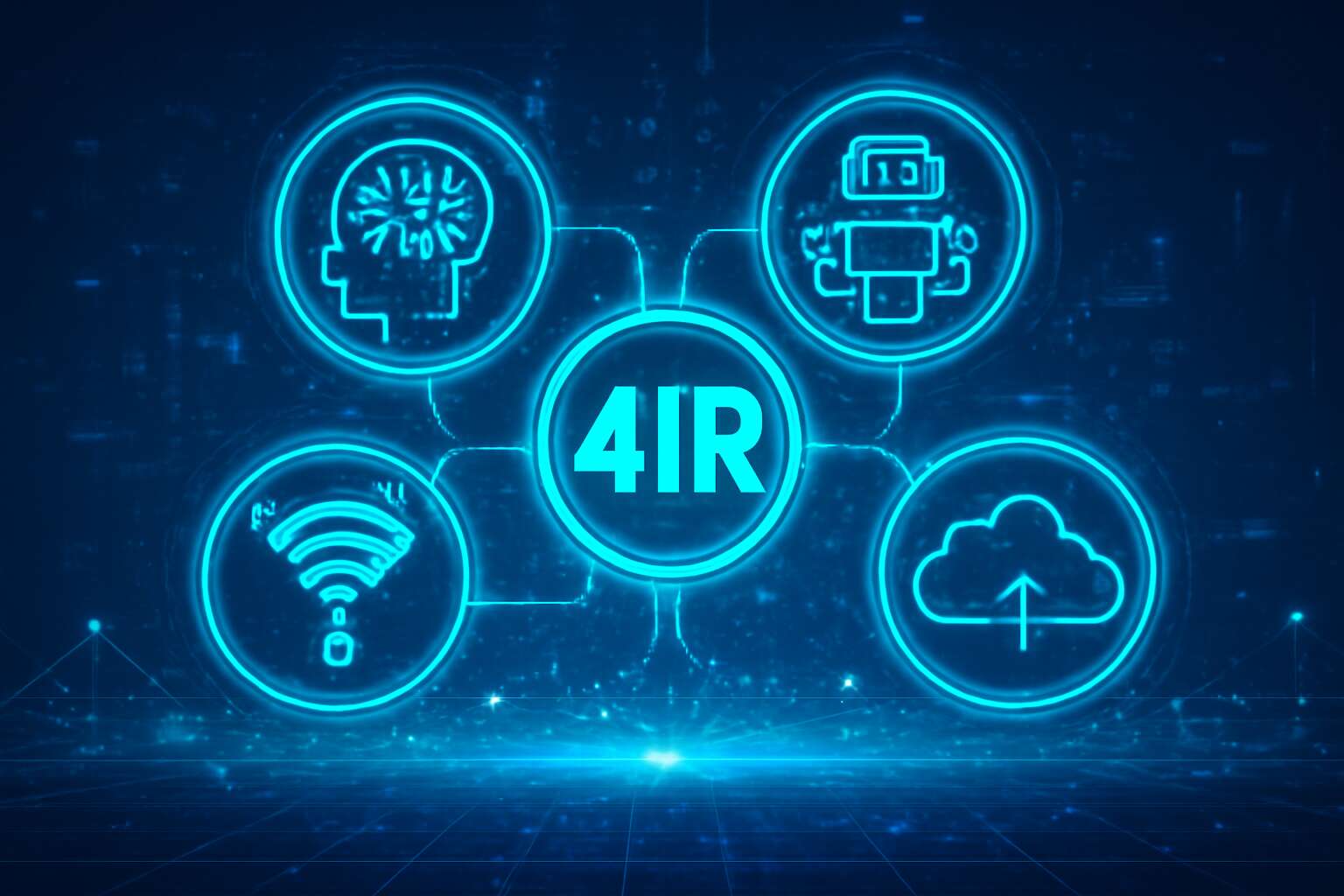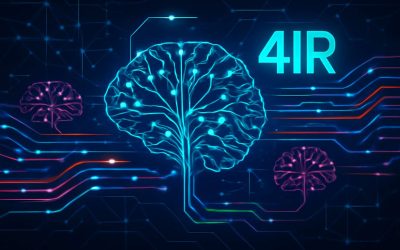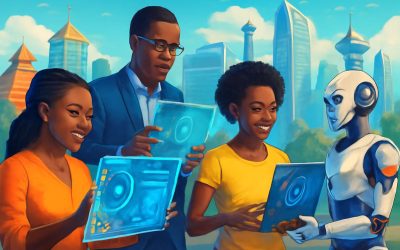Understanding the Fourth Industrial Revolution (4IR)
1.1 – Definition and Overview of 4IR
The Fourth Industrial Revolution, commonly known as 4IR explained, marks a seismic shift in how we live, work, and connect. Unlike previous waves of industrial change, 4IR is driven by an unprecedented fusion of digital, biological, and physical technologies. It’s a transformation that touches every aspect of daily life, from the way farmers tend their crops to how cities manage resources.
At its core, 4IR explained involves the rapid development and integration of advanced innovations such as artificial intelligence, the Internet of Things, and blockchain. These technologies are not only reshaping industries but also redefining societal norms. To grasp the magnitude of this revolution, consider the ways in which automation and data analytics now influence decision-making processes across sectors. This wave of change demands a new level of agility and understanding, making 4IR explained an essential concept for future-oriented strategies.
1.2 – Historical Context: From 1st to 3rd Industrial Revolutions
The story of human progress is written in waves of innovation, each more transformative than the last. The journey from the first to the third industrial revolution reveals a pattern of relentless evolution—yet none compare to the seismic impact of 4IR explained. Historically, the first revolution, driven by steam power, sparked mechanisation and fundamentally reshaped manufacturing. The second, powered by electricity, ushered in mass production and global connectivity. The third, often called the digital revolution, introduced computers and the internet, accelerating data exchange and communication.
Now, we stand on the cusp of the Fourth Industrial Revolution, a phase characterised by the fusion of digital, biological, and physical realms. Unlike its predecessors, 4IR explained is not merely about technological advancement but a profound shift that blurs the lines between man and machine, nature and technology. This transformation is unfolding rapidly, reshaping industries and societal norms alike. To understand this new epoch, one must appreciate the historical context that led us here, building a bridge from past revolutions to the current wave of innovation. The question remains—what comes next in this extraordinary continuum of progress?
1.3 – Key Characteristics of 4IR
The Fourth Industrial Revolution, or 4IR explained, is a transformative wave that is reshaping our world at an unprecedented pace. Unlike previous revolutions driven solely by machinery or digital tools, 4IR is characterised by the seamless integration of digital, biological, and physical systems. This fusion creates a new landscape where innovation is no longer linear but interconnected, often occurring simultaneously across multiple sectors.
Key characteristics of 4IR include rapid technological advancements such as artificial intelligence, robotics, and the Internet of Things (IoT). These innovations enable industries to operate more efficiently, reduce costs, and foster customised solutions. Moreover, 4IR explained emphasises decentralisation—power shifts from centralised institutions to individuals and smaller entities, thanks to digital connectivity.
- Blurring of boundaries between human and machine
- Acceleration of data-driven decision making
- Development of bio-technologies and smart environments
Understanding these core traits reveals how 4IR explained is not just about new gadgets; it’s a profound shift affecting societal norms, economic models, and everyday life. Truly, this revolution is a testament to human ingenuity — a relentless pursuit of progress that brings both challenges and immense opportunities.
1.4 – Why 4IR Matters Today
In a world where technology seems to evolve faster than your favourite streaming service’s new series, understanding the 4IR explained becomes more crucial than ever. This isn’t just about gadgets and gizmos; it’s a seismic shift affecting how we work, live, and interact. With an estimated 70% of jobs already being transformed by 4IR technologies, ignoring this revolution isn’t an option—it’s a recipe for obsolescence.
The 4IR explained reveals a landscape where human ingenuity meets machine intelligence in ways previously thought impossible. From AI-powered chatbots to smart cities, the revolution is shaping our societal norms and economic models with astonishing speed. It’s a whirlwind of innovation that demands our attention—after all, this isn’t just a technological upgrade; it’s an entirely new way of life.
To grasp the significance of 4IR explained, consider these key impacts:
- The rise of decentralised power—think blockchain and digital currencies—shifting control from traditional institutions to individuals and small entities.
- The blurring of boundaries between humans and machines, where bio-technologies and smart environments redefine what it means to be human.
- The acceleration of data-driven decision making, turning vast amounts of information into actionable insights at lightning speed.
In essence, 4IR explained isn’t just a buzzword—it’s the backbone of the new digital age, where innovation is interwoven with every facet of daily life. Whether you’re a business leader, policymaker, or just someone curious about the future, recognising why 4IR matters today helps you stay ahead in this rapidly evolving landscape. After all, in the era of 4IR, those who adapt fastest will thrive—and those who don’t? Well, let’s just say they may find themselves left behind in the dust of this relentless technological marathon.
Core Technologies Driving 4IR
2.1 – Artificial Intelligence and Machine Learning
Artificial Intelligence (AI) and Machine Learning (ML) stand at the very heart of the 4IR explained—revolutionising industries and transforming everyday lives in ways previously unimaginable. These core technologies enable machines to learn from data, recognise patterns, and make decisions with a level of precision that rivals human intelligence. It’s as if the digital brain is awakening, capable of evolving continuously without human intervention.
AI and ML are not just buzzwords—they are catalysts for innovation, powering everything from autonomous vehicles to personalised medicine. Their applications extend beyond convenience, reshaping how businesses operate, and how societies adapt to rapid change. For example, in agriculture, smart algorithms optimise crop yields, ensuring food security for communities that have long struggled with unpredictable weather patterns.
- Big Data: The fuel for AI and ML, providing vast, diverse datasets necessary for accurate learning.
- Deep Learning: Advanced neural networks that mimic human brain functions, enabling machines to handle complex tasks.
- Natural Language Processing: Allowing seamless communication between humans and digital systems, making technology more accessible and intuitive.
In essence, AI and ML are not just technological advancements; they are the engines driving the 4IR explained—blurring the lines between the physical, digital, and biological worlds with unprecedented speed and scope.
2.2 – Internet of Things (IoT) and Smart Devices
In the intricate web of the 4IR explained, the Internet of Things (IoT) and smart devices serve as the pulsating arteries that connect this technological renaissance. Imagine a world where everyday objects—home appliances, wearables, industrial machinery—are not merely passive tools but active participants in an expansive digital ecosystem. This interconnectedness transforms mundane routines into a symphony of data-driven efficiency.
IoT’s real power lies in its ability to generate continuous streams of data, which, when harnessed correctly, can unlock unprecedented levels of optimisation. For instance, smart sensors embedded in urban infrastructure can monitor traffic flow in real-time, reducing congestion and emissions. Similarly, in healthcare, wearable devices track vital signs, delivering insights that can preempt emergencies before they occur.
- Enhanced automation
- Real-time analytics
- Seamless integration of digital and physical environments
These facets illustrate how IoT and smart devices are not just supporting characters but the protagonists in the narrative of the 4IR explained, reshaping industries and daily life with unrelenting momentum. As connectivity deepens, the boundaries between the physical and digital worlds blur, offering a glimpse into a future where intelligent systems anticipate our needs even before we voice them.
2.3 – Robotics and Automation
Robotics and automation stand at the very core of the 4IR explained, reshaping the fabric of industries and human experiences alike. These technologies aren’t merely about replacing manual labour; they embody a profound shift towards intelligent systems that learn, adapt, and operate autonomously. As machines become more perceptive and precise, they challenge our notions of craftsmanship, creativity, and control.
Behind this transformation lies a complex interplay of core technologies that drive the 4IR explained. Robotics, in particular, harness a synergy of sensors, actuators, and AI algorithms to execute tasks once thought impossible for machines. These systems are now capable of performing intricate operations with uncanny accuracy—whether assembling microchips or assisting in delicate surgical procedures.
To truly grasp the magnitude of this shift, consider the following:
- Advanced robotics integrated with machine learning enable self-improving systems that optimise themselves without human intervention.
- Automation tools facilitate seamless workflows, dramatically increasing efficiency and reducing human error.
- Predictive analytics embedded within these systems anticipate issues before they materialise, turning reactive processes into proactive strategies.
In essence, robotics and automation are not merely technological novelties; they are the catalysts propelling us into an era where machines and humans coalesce into a symbiotic entity. The 4ir explained reveals that this integration is the pulse beating at the heart of our rapidly evolving digital landscape—an evolution that demands both awe and introspection.
2.4 – Blockchain and Decentralization
Amidst the swirling currents of technological evolution, blockchain and decentralization emerge as the unbreakable backbone of the 4IR explained. These core technologies forge a new realm where trust is decentralised, and transparency becomes the currency of progress. Unlike traditional systems, blockchain offers a ledger that is immutable, secure, and accessible to all, fostering an era of peer-to-peer exchanges without intermediaries.
Decentralization dismantles hierarchical structures, replacing them with a resilient network of interconnected nodes, each holding a piece of the truth. This distributed architecture fuels innovations such as cryptocurrencies, smart contracts, and decentralised applications—each a testament to the disruptive power of the 4ir explained.
- Enhanced security through cryptography, making data tampering nearly impossible.
- Greater autonomy for users, empowering individuals and organisations alike.
- Reduced reliance on central authorities, accelerating trustless transactions and collaborations.
In the grand tapestry of the 4ir explained, blockchain and decentralization are not merely threads but vibrant hues that redefine the fabric of digital interaction—an evolution where sovereignty and transparency reign supreme, transforming the way we conceive trust in an increasingly interconnected world.
Impacts of 4IR on Society and Business
3.1 – Transformations in Industries (Manufacturing, Healthcare, Agriculture)
The dawn of the Fourth Industrial Revolution (4IR) has sent ripples through society and business alike, transforming traditional sectors with unprecedented speed. As 4IR explained, industries are experiencing a seismic shift driven by advanced technologies that redefine operational paradigms. This revolution is not merely about automation; it’s about intelligent systems that learn, adapt, and innovate.
Take manufacturing, for instance. The rise of smart factories leverages connected devices and real-time data analysis, resulting in increased efficiency and precision. Healthcare is also undergoing a metamorphosis, with AI-powered diagnostics and robotic surgeries pushing the boundaries of what’s medically possible. Meanwhile, agriculture benefits from precision farming techniques that optimise resource use and boost yields. These transformations exemplify how 4IR explained reveals a future where industries are interconnected and inherently smarter.
3.2 – Job Market Changes and Skills Development
The advent of the Fourth Industrial Revolution, or 4IR explained, is profoundly reshaping the fabric of society and the world of business. As technology accelerates at an unprecedented pace, its impact on the job market is both complex and significant. Many traditional roles are evolving, while new opportunities emerge that require specialised skills. This transformation calls for continuous learning and adaptability, as workers navigate an environment where automation and artificial intelligence are increasingly prevalent.
In response, skills development becomes more crucial than ever. Embracing lifelong learning, digital literacy, and critical thinking can open doors to fields that did not exist a decade ago. The integration of 4IR technologies means that industries now demand talent capable of working alongside intelligent systems. To thrive in this new landscape, individuals and organisations alike must foster resilience and innovation, ensuring that the benefits of 4IR explained translate into sustainable growth and inclusive prosperity.
3.3 – Ethical and Privacy Concerns
The impact of the Fourth Industrial Revolution (4IR explained) extends beyond factories and office spaces, permeating the very fabric of society and the core of modern business. As intelligent systems become more integrated into daily life, ethical and privacy concerns take centre stage. People worry about how their personal data is collected, stored, and used—raising questions about consent and security in an era of pervasive connectivity.
For organisations, navigating these challenges requires a delicate balance. Implementing innovative technologies like AI and IoT can unlock remarkable efficiencies, but without proper safeguards, they risk eroding trust. A growing list of concerns includes data breaches, surveillance, and the ethical dilemmas surrounding autonomous decision-making. As 4IR explained reveals, safeguarding privacy and ensuring ethical standards are not just optional; they are essential for sustainable growth in this brave new world.
3.4 – Opportunities for Innovation and Growth
The Fourth Industrial Revolution (4IR explained) is transforming society and business in ways we once only dreamed of. From smart cities to autonomous vehicles, the ripple effects are profound, creating a landscape where innovation is both the driver and the destination. As this wave surges forward, it opens up a treasure trove of opportunities for growth and inventive disruption.
Businesses are leveraging 4IR technologies to streamline operations, personalise customer experiences, and unlock new revenue streams. For example, integrating AI-driven analytics helps companies anticipate market trends with uncanny precision, while IoT devices enable real-time monitoring that was unthinkable a decade ago. The result? An ecosystem ripe for innovation that can outpace competitors in a blink of an eye.
On the societal front, 4IR explained reveals a world where digital connectivity becomes deeply embedded in daily life. This creates new avenues for social development, economic inclusion, and smarter urban living. Yet, with these bright prospects come challenges—such as navigating the ethical dilemmas of autonomous decision-making and ensuring that technological progress benefits everyone, not just the tech giants. It’s a delicate dance of harnessing potential while safeguarding core human values.
Challenges and Risks of 4IR Adoption
4.1 – Digital Divide and Accessibility Issues
While the 4IR explained reveals a world of transformative potential, it also exposes significant challenges that threaten to widen existing inequalities. One of the most pressing issues is the digital divide, where access to advanced technologies remains uneven across regions and socio-economic groups. This gap hampers widespread adoption and leaves vulnerable populations behind in the race towards innovation.
Accessibility issues are not just about infrastructure but also include digital literacy and affordability. Without equitable access, the promise of 4IR technologies like artificial intelligence and blockchain risks becoming a tool for privilege rather than progress. Addressing these disparities requires deliberate policy measures and investment in universal digital infrastructure, ensuring that the benefits of 4IR explained are inclusive rather than exclusive.
Furthermore, the rapid pace of technological change can exacerbate social and economic divides, creating a risk of marginalising those unable or unwilling to adapt. As 4IR continues to unfold, understanding its challenges becomes crucial to fostering a more equitable future where innovation benefits everyone, not just a select few.
4.2 – Cybersecurity Threats
As the 4IR explained reveals, the digital revolution isn’t just about shiny new gadgets; it’s a seismic shift that could either propel society forward or leave some behind in a digital dustbin. But with great technological power comes great cybersecurity threats. Hackers and cybercriminals are evolving faster than AI algorithms, targeting vulnerable networks that lack robust security measures. The rapid adoption of interconnected devices creates a sprawling attack surface that’s as tempting as a digital candy store for cyber villains.
One of the key challenges in understanding the 4IR explained is navigating the labyrinth of cybersecurity risks. These include data breaches, ransomware attacks, and even manipulation of autonomous systems. For organisations embracing 4IR technologies, the stakes couldn’t be higher—failure to secure digital infrastructure can result in financial ruin, compromised privacy, or worse, a loss of public trust. It’s a high-stakes game of digital whack-a-mole, where the threats are constantly evolving.
To make matters worse, the proliferation of smart devices and IoT (Internet of Things) gadgets often comes with a false sense of security. Many devices lack proper encryption or security protocols, turning them into potential gateways for cyber intrusion. This is where a simple
- weak password
- unpatched software
- poor network segmentation
can turn a company’s digital ecosystem into Swiss cheese, inviting chaos. As the 4IR explained, cybersecurity isn’t just an IT issue; it’s a strategic imperative for any organisation daring to innovate in this brave new world.
Ultimately, the challenge isn’t just about defending against cyber threats—it’s about staying ahead of them. Because in the 4IR explained, the rules of engagement are constantly rewritten by digital villains who see vulnerabilities as opportunities. For businesses and governments alike, understanding and mitigating these cybersecurity threats is essential if we’re to enjoy the full benefits of this technological renaissance without becoming cyber crime’s next victim.
4.3 – Regulatory and Legal Frameworks
As the shadow of the 4IR looms larger, the labyrinth of regulatory and legal frameworks becomes a terrain riddled with ambiguity and peril. Governments and corporations alike grapple with the challenge of crafting rules that can keep pace with relentless technological innovation. The 4ir explained reveals a landscape where existing laws often fall silent, unable to address the novel dilemmas posed by autonomous systems and data sovereignty.
In this dark dance of progress, the most treacherous risk is the fragmentation of legal standards across borders. Without harmonised regulations, a rogue nation or unregulated entity could exploit the chaos, unleashing chaos upon interconnected networks. To navigate this treacherous terrain, some countries are adopting a layered approach—balancing innovation with oversight—yet the path remains fraught with uncertainty.
Moreover, the rapid pace of change amplifies the risk of legal obsolescence, leaving organisations vulnerable to unanticipated liabilities. As the 4ir explained, the challenge is not merely compliance but a strategic foresight—anticipating future regulations before they materialise in the shadows of legislative chambers. Only then can organisations hope to safeguard their digital dominions while embracing the promise of this new era.
4.4 – Managing Technological Disruption
The relentless march of the 4IR explained reveals a landscape fraught with profound challenges and unpredictable risks. As organisations race to harness emerging technologies, managing the disruption becomes an existential quest. The speed at which artificial intelligence, IoT, and automation reshape industries leaves little room for complacency, forcing leaders to confront an uncertain future.
One of the most insidious risks is the potential for destabilising technological upheaval. Rapid innovation can render existing business models obsolete overnight, demanding agility and foresight. The fear of falling behind fuels a cycle where companies scramble to adapt, often without fully understanding the long-term consequences. This turbulence isn’t limited to corporate corridors; societal structures are also vulnerable to fragmentation if regulation lags behind innovation.
Addressing these risks requires a nuanced approach. Some nations are adopting layered strategies—balancing innovation with regulation, yet the path remains riddled with ambiguity. In this dark dance of progress, a failure to anticipate legal and ethical dilemmas can lead to irreversible damage. The real challenge lies in navigating the fine line between embracing disruption and maintaining stability—an ongoing struggle encapsulated by the very essence of 4IR explained.
Preparing for a 4IR Future
5.1 – Skills for the Future Workforce
Preparing for a 4IR future isn’t just about keeping up with technology; it’s about transforming the very foundation of workforce skills. As industries evolve at an unprecedented pace, the demand for adaptable, innovative professionals grows exponentially. The key to thriving in this new era lies in cultivating a set of versatile competencies that align with 4ir explained principles—embracing change, mastering digital fluency, and fostering creative problem-solving.
To navigate the complexities of 4ir explained, individuals need to develop skills that go beyond traditional expertise. For example, critical thinking and emotional intelligence are more vital than ever, enabling workers to adapt to rapid automation and AI integration. Additionally, a proactive approach to continuous learning ensures that the workforce remains resilient amidst technological disruptions.
In this context, familiarity with emerging technologies such as artificial intelligence, blockchain, and IoT is essential. Equipping oneself with these skills involves engaging in specialised training or immersive educational programmes, often structured around real-world applications. Recognising the importance of lifelong learning is the secret to staying relevant in a landscape where skills become obsolete faster than ever before.
5.2 – Policy and Governance Strategies
As the digital landscape morphs at an unprecedented velocity, the role of effective policy and governance strategies becomes paramount in shaping a resilient 4IR ecosystem. Navigating this complex terrain requires more than reactive measures; it demands a proactive, visionary approach that anticipates technological shifts while safeguarding societal interests. Governments and organisations must craft frameworks that foster innovation without compromising ethical standards or security.
Embedding principles such as transparency, accountability, and inclusivity into policy design is essential. This ensures that the benefits of 4IR are accessible to all, mitigating the risk of deepening the digital divide. A well-structured regulatory environment can accelerate technological adoption and protect citizens from emerging cyber threats. Remember, the real challenge lies in balancing rapid innovation with responsible oversight — a core tenet of 4IR explained.
- Establishing clear legal frameworks for emerging technologies
- Promoting cross-sector collaboration among stakeholders
- Implementing adaptive policies that evolve alongside technological advancements
By aligning governance strategies with the intricacies of 4ir explained, societies can create fertile ground for sustainable growth, innovation, and inclusive prosperity. It’s a delicate dance of foresight and flexibility — a testament to how policy can be a powerful catalyst in this new industrial revolution.
5.3 – Investing in Technology and Infrastructure
Preparing for a 4IR future demands more than just understanding the technological landscape; it requires strategic investment in both infrastructure and innovation. As industries evolve at an unprecedented pace, countries and organisations must be proactive in building resilient digital ecosystems. This means prioritising the deployment of high-speed connectivity, data centres, and advanced computing resources that can handle the immense data flows characteristic of 4IR technologies.
To truly grasp the implications of 4IR explained, stakeholders should focus on fostering an environment where cutting-edge tools like AI, IoT, and blockchain can thrive. This involves not only upgrading physical infrastructure but also cultivating the digital literacy necessary for a skilled workforce. An effective approach might include the following:
- Investing in next-generation broadband networks
- Developing smart cities with integrated digital systems
- Supporting research and development hubs that pioneer emerging technologies
By doing so, societies can create a fertile ground for innovation, ensuring that technological advancements translate into tangible economic growth and societal benefits. The real challenge lies in aligning infrastructure investments with long-term visions, making every digital leap count in the journey to fully realise the potential of 4IR explained.
5.4 – Lifelong Learning and Adaptability
In the continuous dance of progress, the rhythm of the Fourth Industrial Revolution—often called 4IR—demands more than just technological awareness; it calls for an agile mind and an adaptable spirit. Preparing for a 4IR future hinges on fostering lifelong learning, where curiosity becomes a vital currency. As industries shift and evolve at an unprecedented velocity, staying ahead requires resilience and a commitment to perpetual education.
Embracing a culture of adaptability involves cultivating skills that transcend traditional boundaries. Instead of fixed expertise, the focus should be on developing flexible competencies that can pivot with emerging technologies. For example, mastering digital literacy, critical thinking, and innovative problem-solving equips individuals to navigate the complex landscape of 4IR explained. This continuous learning journey ensures that workers remain relevant amid rapid automation and digital transformation.
Furthermore, fostering an environment that encourages curiosity and experimentation is essential. Initiatives like reskilling programmes, online courses, and industry collaborations can unlock new avenues of growth. After all, the true power of 4IR explained lies in our collective capacity to adapt swiftly, turning technological upheaval into opportunities for societal enrichment and economic resilience. In this way, lifelong learning becomes the compass guiding us through the kaleidoscope of the 4IR future.




0 Comments